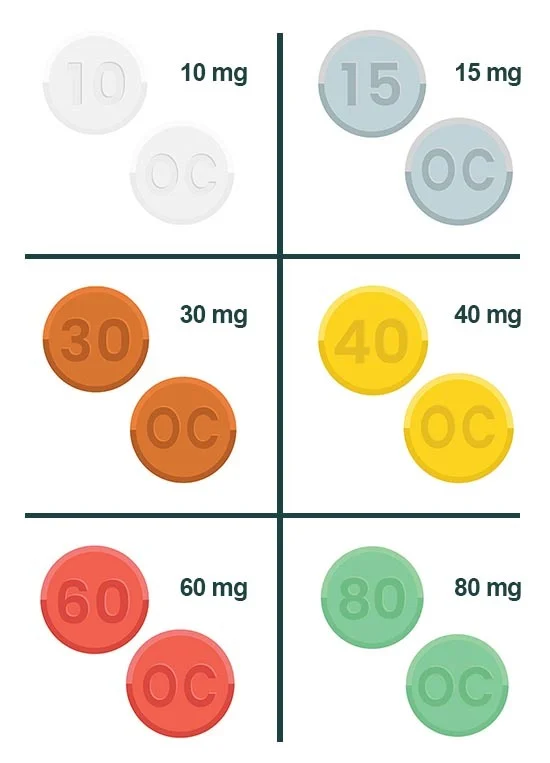Knowing how to identify OxyContin pills is important. This information can help you determine whether a loved one is abusing this drug or it can help you make sure you keep these pills in a safe location.
Oxycontin Pill Identifier
OxyContin usually comes as a small round pill, and it has different, numbered markings and colors depending on the dosage. Most OxyContin pills are also marked with OC or OP on the side opposite the number.
OxyContin pills can look like any of the following:

Oxycontin tablets are available by prescription in strengths of 10 mg, 15 mg, 20 mg, 30 mg, 40 mg, 60 mg and 80 mg.
Treatment Can Be Life Changing. Reach out today.
Whether you are struggling with addiction, mental health or both, our expert team is here to guide you every step of the way. Don’t wait— reach out today to take the first step toward taking control of your life.
- 10 mg OxyContin is round, white and marked with the number 10
- 15 mg OxyContin is gray, round and marked with the number 15
- 30 mg OxyContin is brown, round and marked with the number 30
- 40 mg OxyContin is yellow, round and marked with the number 40
- 60 mg OxyContin is red, round and marked with the number 60
- 80 mg OxyContin is green, round and marked with the number 80
Due to the rise in abuse of OxyContin, all of the pills are now crush-resistant.
What Is OxyContin?
You may have heard of OxyContin because it is one of the most widely prescribed and abused opioids in the United States.
OxyContin is one of the top drugs that lead to overdoses and deaths in the United States. However, the drug is not without therapeutic value.
OxyContin is the brand name of the opioid oxycodone and it’s used to treat chronic pain ranging from moderate to severe. Many opioids are designed to treat pain on an as-needed basis, so a person would take them for acute pain every four to six hours or whenever they felt they needed them. OxyContin is an extended-release medicine, which means that it’s used for the around-the-clock treatment of pain.
OxyContin is meant to release slowly into the system and keep pain at bay for up to 12 hours. It’s often used in patients who already have a tolerance to other opioids because it is so potent.
What Are The Side Effects of OxyContin Pills?
Many mild side effects of OxyContin pills may occur such as nausea, vomiting, dizziness and drowsiness.
There is also the potential for more severe side effects with OxyContin pills. One of the most serious side effects is respiratory depression. OxyContin and opioids relieve pain by binding to certain receptors in the central nervous system (CNS). When bound, the drug slows the activity of the CNS. If someone’s CNS slows too much, it can lead to respiratory depression that ultimately causes death. This risk is heightened when OxyContin pills are mixed with another substance that has a similar effect, such as alcohol or benzodiazepines.
Knowing what OxyContin looks like can help you identify if someone you know is addicted to the medication. If you know someone who is misusing OxyContin or other prescription drugs,contact The Recovery Villageto learn more about treatment options and specialized programs.








